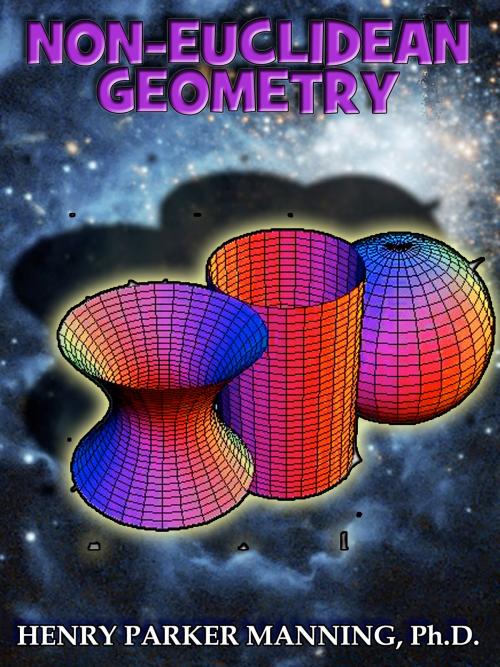Non-Euclidean Geometry (illustrated)
Nonfiction, Science & Nature, Mathematics, Pre-Calculus, Geometry, Calculus| Author: | Henry P. Manning | ISBN: | 1230000138550 |
| Publisher: | Manning | Publication: | June 4, 2013 |
| Imprint: | Language: | English |
| Author: | Henry P. Manning |
| ISBN: | 1230000138550 |
| Publisher: | Manning |
| Publication: | June 4, 2013 |
| Imprint: | |
| Language: | English |
Non-Euclidean Geometry is now recognized as an important branch of Mathematics.
Those who teach Geometry should have some knowledge of this subject, and all who are interested in Mathematics will find much to stimulate them and much for them to enjoy in the novel results and views that it presents.
This book is an attempt to give a simple and direct account of the Non-Euclidean Geometry, and one which presupposes but little knowledge of Mathematics.
The first three chapters assume a knowledge of only Plane and Solid Geometry and Trigonometry, and the entire book can be read by one who has taken the mathematical courses commonly given in our colleges.
No special claim to originality can be made for what is published here. The propositions have long been established, and in various ways. Some of the proofs may be new, but others, as already given by writers on this subject, could not be improved. These have come to me chiefly through the translations of Professor George Bruce Halsted of the University of Texas.
I am particularly indebted to my friend, Arnold B. Chace, Sc.D., of Valley Falls, R. I., with whom I have studied and discussed the subject.
HENRY P. MANNING.
CONTENTS:
• Pangeometry
• Propositions Depending Only on the Principle of Superposition
• Propositions Which Are True for Restricted Figures
• The Three Hypotheses
• The Hyperbolic Geometry
• Parallel Lines
• Boundary-curves and Surfaces, and Equidistant-curves and Surfaces 35
• Trigonometrical Formulæ
• The Elliptic Geometry
• Analytic Non-Euclidean Geometry
• Hyperbolic Analytic Geometry
• Elliptic Analytic Geometry
• Elliptic Solid Analytic Geometry
• Historical Note
The axioms of Geometry were formerly regarded as laws of thought which an intelligent mind could neither deny nor investigate. Not only were the axioms to which we have been accustomed found to agree with our experience, but it was believed that we could not reason on the supposition that any of them are not true, it has been shown, however, that it is possible to take a set of axioms, wholly or in part contradicting those of Euclid, and build up a Geometry as consistent as his.
We shall give the two most important Non-Euclidean Geometries. 1 In these the axioms and definitions are taken as in Euclid, with the exception of those relating to parallel lines. Omitting the axiom on parallels,2 we are led to three hypotheses; one of these establishes the Geometry of Euclid, while each of the other two gives us a series of propositions both interesting and useful. Indeed, as long as we can examine but a limited portion of the universe, it is not possible to prove that the system of Euclid is true, rather than one of the two Non-Euclidean Geometries which we are about to describe.
We shall adopt an arrangement which enables us to prove first the propositions common to the three Geometries, then to produce a series of propositions and the trigonometrical formulæ for each of the two Geometries which differ from that of Euclid, and by analytical methods to derive some of their most striking properties.
We do not propose to investigate directly the foundations of Geometry, nor even to point out all of the assumptions which have been made, consciously or unconsciously, in this study. Leaving undisturbed that which these Geometries have in common, we are free to fix our attention upon their differences. By a concrete exposition it may be possible to learn more of the nature of Geometry than from abstract theory alone.
Non-Euclidean Geometry is now recognized as an important branch of Mathematics.
Those who teach Geometry should have some knowledge of this subject, and all who are interested in Mathematics will find much to stimulate them and much for them to enjoy in the novel results and views that it presents.
This book is an attempt to give a simple and direct account of the Non-Euclidean Geometry, and one which presupposes but little knowledge of Mathematics.
The first three chapters assume a knowledge of only Plane and Solid Geometry and Trigonometry, and the entire book can be read by one who has taken the mathematical courses commonly given in our colleges.
No special claim to originality can be made for what is published here. The propositions have long been established, and in various ways. Some of the proofs may be new, but others, as already given by writers on this subject, could not be improved. These have come to me chiefly through the translations of Professor George Bruce Halsted of the University of Texas.
I am particularly indebted to my friend, Arnold B. Chace, Sc.D., of Valley Falls, R. I., with whom I have studied and discussed the subject.
HENRY P. MANNING.
CONTENTS:
• Pangeometry
• Propositions Depending Only on the Principle of Superposition
• Propositions Which Are True for Restricted Figures
• The Three Hypotheses
• The Hyperbolic Geometry
• Parallel Lines
• Boundary-curves and Surfaces, and Equidistant-curves and Surfaces 35
• Trigonometrical Formulæ
• The Elliptic Geometry
• Analytic Non-Euclidean Geometry
• Hyperbolic Analytic Geometry
• Elliptic Analytic Geometry
• Elliptic Solid Analytic Geometry
• Historical Note
The axioms of Geometry were formerly regarded as laws of thought which an intelligent mind could neither deny nor investigate. Not only were the axioms to which we have been accustomed found to agree with our experience, but it was believed that we could not reason on the supposition that any of them are not true, it has been shown, however, that it is possible to take a set of axioms, wholly or in part contradicting those of Euclid, and build up a Geometry as consistent as his.
We shall give the two most important Non-Euclidean Geometries. 1 In these the axioms and definitions are taken as in Euclid, with the exception of those relating to parallel lines. Omitting the axiom on parallels,2 we are led to three hypotheses; one of these establishes the Geometry of Euclid, while each of the other two gives us a series of propositions both interesting and useful. Indeed, as long as we can examine but a limited portion of the universe, it is not possible to prove that the system of Euclid is true, rather than one of the two Non-Euclidean Geometries which we are about to describe.
We shall adopt an arrangement which enables us to prove first the propositions common to the three Geometries, then to produce a series of propositions and the trigonometrical formulæ for each of the two Geometries which differ from that of Euclid, and by analytical methods to derive some of their most striking properties.
We do not propose to investigate directly the foundations of Geometry, nor even to point out all of the assumptions which have been made, consciously or unconsciously, in this study. Leaving undisturbed that which these Geometries have in common, we are free to fix our attention upon their differences. By a concrete exposition it may be possible to learn more of the nature of Geometry than from abstract theory alone.















